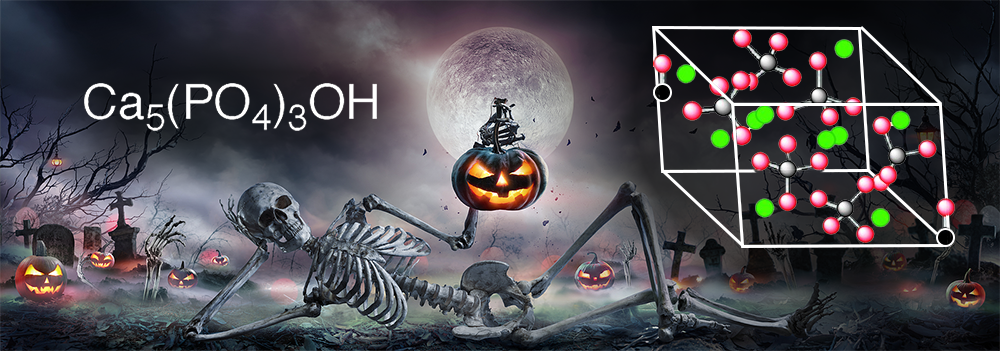What molecule am I?

Hydroxyapatite, sometimes referred to as durapatite, is a calcium phosphate/hydroxide mineral that occurs naturally in “phosphate rock”. It is also present in as much as 70 wt% of human bone.
Although the formula for hydroxyapatite is usually expressed as Ca5(PO4)3OH, it is sometimes given as Ca10(PO4)6OH2 or 3Ca2(PO4)2CaOH2 to indicate that its crystal unit cell consists of two formula weights. In the 3-D image shown above, calcium is represented in green, phosphorus in gray, oxygen in pink, and hydrogen in black.
In addition to natural hydroxyapatite, the commercial substance is frequently synthetic. It was made as long ago as 1873, when British agricultural chemist Robert Warington, Jr., prepared it from calcium nitrate and potassium dihydrogen phosphate. In modern times, it is synthesized via wet chemical precipitation, biomimetic deposition, or electrodeposition. One biosynthetic method that used the bacterium Klebsiella pneumoniae was reported in 2019 by Arivalagan Pugazhendhi, Rathinasamy Subashkumar, and coauthors at institutions in India and Viet Nam.
Natural hydroxyapatite contains impurities, so its main use is as a source of phosphate and subsequently other phosphorus-containing compounds. The much purer synthetic material is used to form artificial teeth and bones or repair natural tissues. Several aspects of hydroxyapatite chemistry and biology are covered in the ScienceDirect page about the molecule.
When you see skeletons hanging about this Halloween week, think of hydroxyapatite!
Hydroxyapatite hazard information
| Hazard class* | GHS code and hazard statement |
|---|---|
| Not a hazardous substance or mixture |
*Globally Harmonized System (GHS) of Classification and Labeling of Chemicals.
MOTW update
Vitamin A1, also called retinol, was one of the Molecules of the Week for June 10, 2014. It is essential for animals’ growth, development, and strong vision, and for establishing prenatal immune systems.
Earlier this month, Christophe M. Courtin and co-workers at the Catholic University of Leuven (Heverlee, Belgium) reported that retinyl palmitate2, a form of vitamin A used as a food supplement, can be stabilized to prevent oxidation during long-term storage by combining it with cereal bran. In a high-temperature storage study, wheat bran, in particular, stabilized vitamin A most effectively, retaining its activity by 78% after 2 weeks, compared with 26% retention in the absence of the bran.
1. CAS Reg. No. 68-26-8.
2. CAS Reg. No. 79-81-2.
This molecule was suggested by a reader. We present almost all of the molecules suggested by our readers. If you have a molecule you would like us to consider, please send us a message. And thank you for your interest in Molecule of the Week! —Ed.
Hydroxyapatite fast facts
| CAS Reg. No. | 1306-06-5 |
| SciFinder nomenclature | Hydroxylapatite [Ca5(OH)(PO4)3] |
| Empirical formula | Ca5HO13P3 |
| Formula mass | 502.31 g/mol |
| Appearance | White crystals or powdera |
| Melting point | ≈1500 °Cb |
| Water solubility | Very slightly solublec |
a. Impure samples may be gray, yellow, or green.
b. Reported values range from 1100 to 1700 °C.
c. Extensive studies exist on the water solubility of hydroxyapatite. One study reports a value of 44 μg/L at 37 °C.

Learn more about this molecule from CAS, the most authoritative and comprehensive source for chemical information.
Molecule of the Week needs your suggestions!
If your favorite molecule is not in our archive, please send us a message. The molecule can be notable for its current or historical importance or for any quirky reason. Thank you!
Stay Ahead of the Chemistry Curve
Learn how ACS can help you stay ahead in the world of chemistry.

